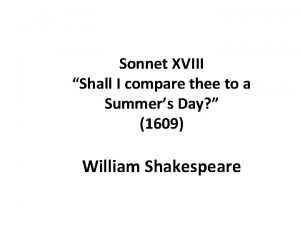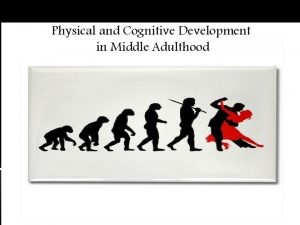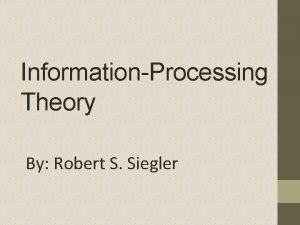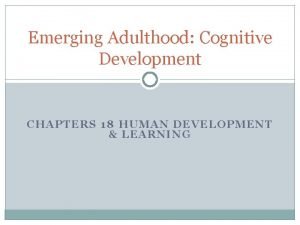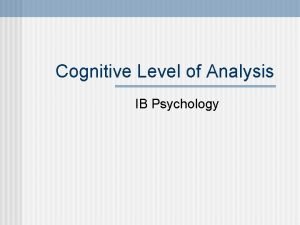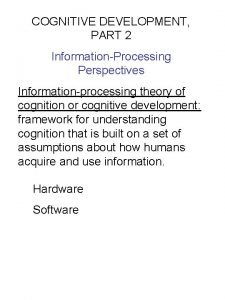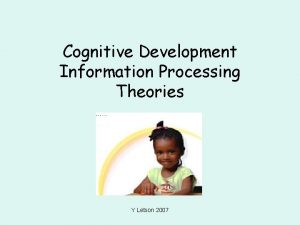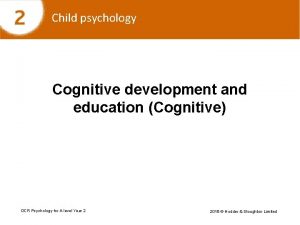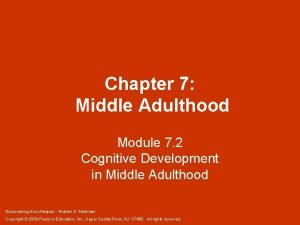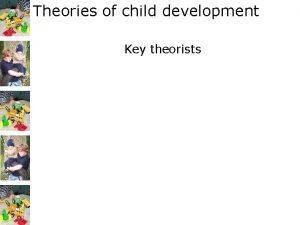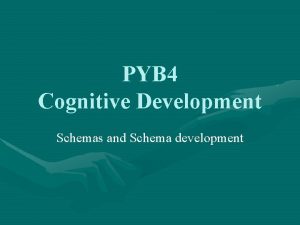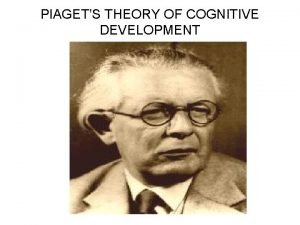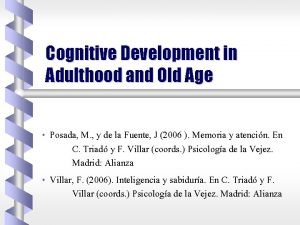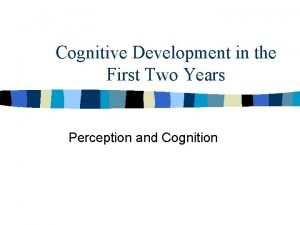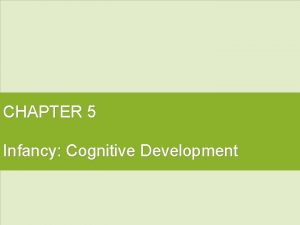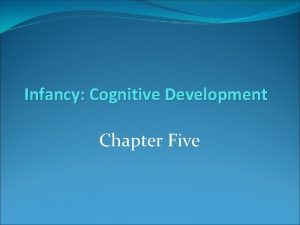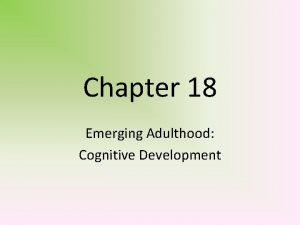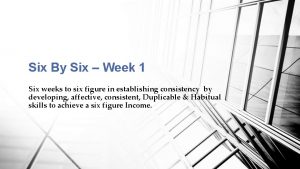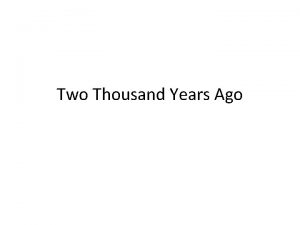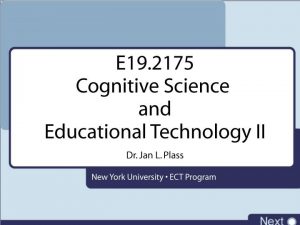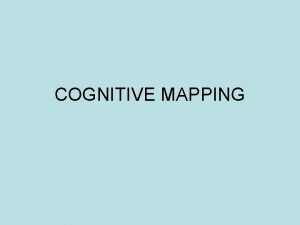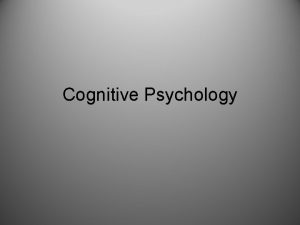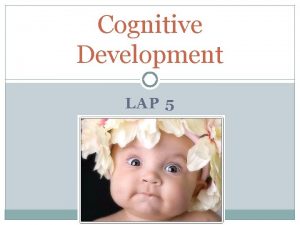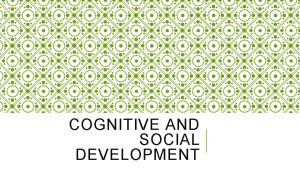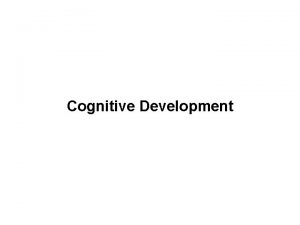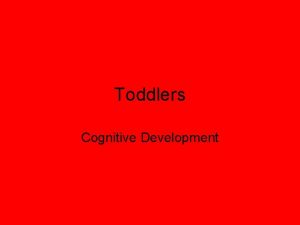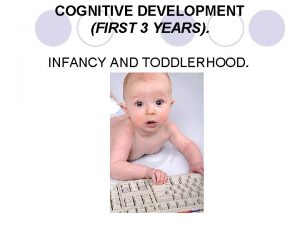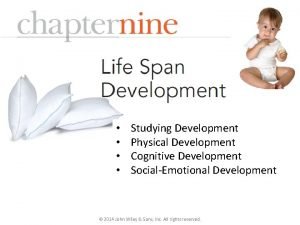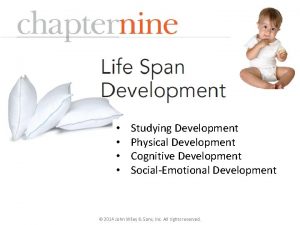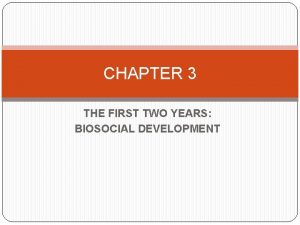Chapter Six The First Two Years Cognitive Development




























- Slides: 28

Chapter Six The First Two Years: Cognitive Development Power. Points prepared by Cathie Robertson, Grossmont College

Sensorimotor Intelligence • Sensoritmotor intelligence—active intelligence causing babies to think while using senses and motor skills

Stages 1 and 2: Primary Circular Reactions • The feedback loop involving the infants own body; infant senses motion and tries to make sense of it • Stage 1 = Reflexes • Stage 2 = First Acquired Adaptations - adaptations of reflexes, i. e. , sucking—new information taken in by senses and responded to

Stages 1 and 2: Primary Circular Reactions, cont. • Assimilation and Accommodation – assimilation—taking in new information by incorporating it into previous knowledge – accommodation— intake of new data to readjust, refine, expand prior schema or actions – babies eagerly adapt their reflexes and senses to whatever experiences they have

Stages 1 and 2: Primary Circular Reactions, cont. • Sucking as a Stage-Two Adaptation – begin adapting at about one month – reflexive assimilation

Stages 3 and 4: Secondary Circular Reactions • feedback loop involving people and objects • Stage 3 = Making Interesting Events Last - repetition - awareness • Stage 4 = New Adaptation and Anticipation - goal-directed behavior - object permanence

Stages 5 and 6: Tertiary Circular Reactions • Feedback loop that involves active experimentation and exploration - involves creativity, action, and ideas • Stage 5 = New Means Through Active Experimentation – little scientist

Stages 5 and 6: Tertiary Circular Reactions, cont. • Stage 6 = New Means Through Mental Combinations – mental combinations—sequence of mental actions tried out before actual performance – deferred imitation—perception of something someone else does (modeling), then performing action at a later time

Piaget and Modern Research • Habituation—process of getting used to an object or event through repeated exposure to it • f. MRI—functional magnetic resonance imaging measuring technique for brain activity and neurological responses • First three years are prime time for cognitive development

Information Processing • Information-processing theory— perspective that compares human thinking processes to computer analysis of data, including sensory input, stored memories, and output

Affordances • Affordances—opportunities for perception and interaction offered by environment • How something is perceived and acted upon depends on – – past experiences current developmental level sensory awareness of opportunities immediate needs and motivation

Sudden Drops • Visual cliff measures depth perception, which is based not on maturity level but affordance - depends on prior experience • Object Constancy - things remain what they are, despite changes in perception or appearance - boundaries of three-dimensional objects

Movement and People • Dynamic perception— 1 of the 2 principles explaining infant perception; namely, that from birth perception is primed to focus on movement and change • 2 nd principle explaining infant perception is that babies are fascinated by people • Infants most interested in emotional affordances of their caregivers

Memory • Certain amount of experience and maturation in order to process and remember experiences • In first year infants have great difficulty storing new memories • Older children often unable to describe events that occurred when they were younger

Memory, cont. • Very early memories possible if – situation similar to real life – motivation high – special measures aid retrieval by acting as reminders

Reminders and Repetition • Reminder session—any perceptual experience that helps a person recall an idea or experience

A Little Older, A Little More Memory • After 6 months infants capable of retaining information for longer periods of time with less reminding • Deferred imitation apparent after end of first year • By middle of the 2 nd year, children capable of remembering and reenacting complex sequences

A Little Older, A Little More Memory, cont. • Memory is not just single entity; distinct brain regions for particular aspects of memory; humans have a memory for – – – words images actions smells experiences “memorized” facts

Language: What Develops in Two Years? • Most impressive intellectual achievement of young child and also of all humans

The Universal Sequence of Language Development • Children around the world have the same sequence of early language development but – timing and depth of linguistic ability vary

First Noises and Gestures • Baby talk—high-pitched, simplified, and repetitive ways adults talk to babies • Vocalization – crying – cooing • Babbling – deaf babies do it later and less frequently, but are more advanced in use of gestures

First Words • First word and sentences at age of 1 year

The Language Explosion and Early Grammar • Naming explosion—sudden increase in infant vocabulary, especially nouns, beginning at 18 months • Holophrase—single word that expresses a complete, meaningful thought • Grammar—all the methods that languages use to communicate meaning

Theories of Language Learning • Even the very young use language well • Three schools of thought – infants are taught language – infants teach themselves – social impulses foster infant language

Theory 1: Infants are Taught • Skinner’s reinforcement theory: quantity and quality of talking to child affects rate of language development (learned) – parents are good instructors – baby talk characterized by • • • high pitch simpler vocabulary shorter sentence length more questions and commands repetition

Theory 2: Infants Teach Themselves • Chomsky and LAD (Language Acquisition Device)—hypothesized neurological (inborn) structure that prewires all children for language, including basic aspects of intonation, grammar, and vocabulary – infants innately ready to use their minds to understand speak whatever language offered to them – they are experience expectant

Theory Three: Social Impulses Foster Language • Social-pragmatic—social reason for language: to communicate • Infants seek to respond, which shows their being social in nature— and thus mutually dependent—by - vocalizing - babbling - gesturing - listening - pointing

A Hybrid Theory • Emergentist coalition—combination of valid aspects of several theories - cortex contains many language centers - nature provides several paths to learning language
 Cognitive and non cognitive religious language
Cognitive and non cognitive religious language Sheep years to human years
Sheep years to human years 300 solar years to lunar years
300 solar years to lunar years Four score and seven years ago
Four score and seven years ago Chapter 9 early childhood cognitive development
Chapter 9 early childhood cognitive development Chapter 5 cognitive development in infancy and toddlerhood
Chapter 5 cognitive development in infancy and toddlerhood Shall i compare thee to a summer's day annotation
Shall i compare thee to a summer's day annotation Classify each polygon
Classify each polygon Intellectual development in middle adulthood
Intellectual development in middle adulthood Physical development in adulthood
Physical development in adulthood Cognitive development of late childhood
Cognitive development of late childhood Ap psych schema
Ap psych schema Late adulthood intellectual development
Late adulthood intellectual development Gerome bruner
Gerome bruner Siegler information processing theory
Siegler information processing theory Postformal thought
Postformal thought Ib psychology cognitive level of analysis
Ib psychology cognitive level of analysis Characteristics of cognitive development
Characteristics of cognitive development Information processing theory of cognitive development
Information processing theory of cognitive development Information processing theory of cognitive development
Information processing theory of cognitive development Cognitive development and education
Cognitive development and education Middle adulthood cognitive development
Middle adulthood cognitive development Physical development in adulthood
Physical development in adulthood Bandura theory
Bandura theory Cognitive development schema
Cognitive development schema Outline piaget's theory of cognitive development
Outline piaget's theory of cognitive development What is postformal thought
What is postformal thought Conclusion of cognitive development
Conclusion of cognitive development Cognitive theory child development
Cognitive theory child development






